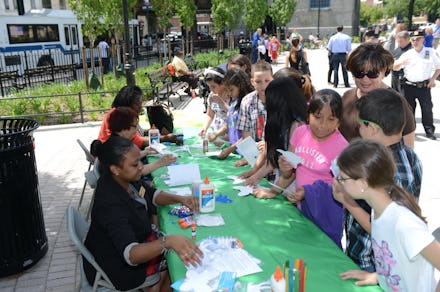You'll Never Guess What Foreign Language is Now Taught in the Bronx

Students at a small public high school in the Bronx are doing something rarely seen in New York City schools: they're learning Persian.
Sara Dingledy, the founder and principal of Westchester Square Academy (WSA), wants "to make sure that kids who come here have the opportunity for some transformative, personal experience."
But Dingledy's decision to implement a Persian language and culture class at WSA was a practical, not a visionary, choice. The school's limited budget forced her to hire only one teacher to be both a foreign language and English as a Second Language teacher.
27-year-old Claire Rann fit the bill. "She could speak Persian," Dingledy says.
But that's not all. Rann has a master's degree in Iranian Studies from St. Andrew's College in Scotland and can recite Iranian history with a fluency few can match. Inside her classroom, however, Rann makes an effort to avoid discussing politics.
"I didn't want to lead off with that," Rann explained. "People tend to latch onto the repressive stuff. I wanted to start with the other cultural stuff."
In many other ways, Rann's approach to teaching Persian language classes defies the model of foreign language instruction commonly practiced throughout the United States. Over the past century, nearly every federally-funded language initiatives came out of a perceived political threat. In the 1960s, the new language of choice was Russian; in the 1980s, it was Japanese. Now, Arabic and Chinese are in fashion.
The National Defense Education Act, which passed in 1958 just after the Soviet Union launched the Sputnik rocket, inspired the spike in Russian language study ,which lasted until the Soviet collapse. A component of the initiative, Title VI, defined foreign language education for the first time in American history.
Title VI has changed over time, but targeting "critical languages," or those crucial to U.S. geopolitical interests, remains its focus. The current list includes Arabic, Chinese, Dari, Persian, Hindi, Korean, and Urdu. These are among the languages that score "bonus points" on the Foreign Service examination.
Shortly after the attacks of September 11, Congress allocated $140.6 million for a so-called National Security Language Initiative. Its purpose was to "engage foreign governments and peoples, especially in critical regions, to encourage reform."
Not surprisingly, Arabic survived and propelled a trend among language programs in the United States. Since 9/11, enrollment in Arabic language programs has increased dramatically. In fact, college campuses nationwide have struggled to meet the growing student demand for Arabic classes.
These federal language initiatives only reflect moments of political flux, while virtually all other education policy within the United States — the No Child Left Behind Act, for example — turns a blind eye to foreign languages, focusing on math and English instead.
By 2008, only a quarter of public and private elementary schools offered foreign language instruction. It is no wonder that the United States is woefully monolingual. Just 18% of Americans speak a second language. In contrast, 53% of Europeans are billingual.
Angela Jackson, the founder of Global Language Project (GLP), seeks to reverse this trend. The organization partners with public New York City elementary schools to establish long-term language programs to encourage early learning. Her program targets disadvantaged elementary school students in under-served communities, many of whom, she says, spend most of their lives within a five-block radius. Jackson cites language as the key that turns neighborhood kids into global citizens.
At a New York University colloquium last February, Jackson demonstrated the potential of her immersion-based program. She played a video of a kindergarten class singing in Arabic, a language that earned the highest level ranking on the U.S. State Department's scale of difficulty.
Meanwhile, in the quest for language acquisition and cultural understanding, Jackson has confronted a different challenge. One of the schools partnered with GLP, Harlem's PS 368, stirred controversy in 2012 after it decided to require all of its students to enroll in Arabic classes.
The resulting dissent was, in many cases, thinly-veiled racism. Right-wing blogger Pamela Geller wrote, "Look what they are doing in Harlem in all places. Do you think the children will be [taught] that blacks are referred to as their abid (slave) and abeed (slaves) in Arabic?"
Jackson says the reaction only highlights the racial ignorance that still exists in America. "It's so important that we do open the minds of our students and our community," she says. "Arabic is one of the most spoken language in the world."
But WSA's small Persian language class has managed to slip under the radar of right-wing bloggers. And in most cases, parents, none of whom have a Persian background, support the choice to teach Persian. "I know there's at least two or three kids whose parents did not want them in the Persian class, but then the kids actually pushed to stay in," Dingledy, the WSA principal, said.
Dingledy hopes that in spite of the current tensions between the United States and the Middle East, her students will be able to take a trip to Iran. "I'm open to the possibility of finding a way to actually have them go," she says.
"Maybe the student embargo is something that's lifted in the next four years as things inevitably thaw. I sort of feel like it's going to thaw, somehow. That's my goal so I guess I'm not deviating from that."